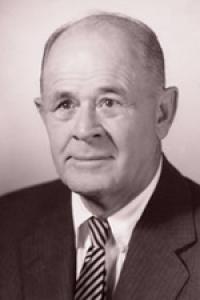
Augereau G. Heinsohn was born in 1896 and lived near Houston. After his service in World War I, Heinsohn returned home and got a job at a cotton goods commission house in New York City, a brokerage firm that acted as an intermediary between the textile mills of the South and the garment industry in Manhattan.
In 1935, the Cherokee Mill in Knoxville, Tennessee, asked A.G. Heinsohn to take over management as it was in desperate financial straits. The situation at Cherokee was almost unsalvageable. Yet Cherokee somehow made the best of a bad situation, paying off a 10-year mortgage lifeline in full in a mere seven years, and bringing Cherokee’s relatively inexperienced new leader to the attention of the rest of the struggling textile sector. In 1939, Heinsohn repeated this success with a second mill, in Spindale, North Carolina, that was in even worse financial condition than Cherokee had been.
Years later, A.G. Heinsohn attributed his success in bringing those two moribund firms back from the dead to his policy of openness and square dealing with his employees.
Heinsohn’s first major brush with the specter of Big Government was a labor dispute. Part of FDR’s New Deal, the Wagner Act and Fair Labor Standards Act, empowered the federal government for the first time to micromanage labor-management relations, dictate work hours and working conditions, and even compel workers to unionize even if they were unwilling to do so. In 1942, the Textile Workers Union of America began trying to organize a union among the workers at Cherokee. Because the Wagner Act prohibited employers from speaking to workers about union-related issues during an organizing campaign, Heinsohn cautioned all of his supervisors to obey this law since, in the anti-management climate of the day, the Labor Board would not hesitate to pounce on any violators, perceived or real.
Before long, the workers at Cherokee were bitterly divided. When a group of pro-union workers tried to forcibly pin union buttons on workers opposed to the union, Heinsohn decided to act to prevent violence, while trying to maintain the neutrality that the new labor laws required. He drew up a letter and sent it to every employee. Even after so many years, the letter is a gem of tact. Explaining that the law required management to remain neutral on whether or not the workers should unionize, Heinsohn spelled out the issue plainly and fairly. As a result of the letter, things settled down, and a few days later, when the vote over unionization was held, the union lost by 37 votes. A second vote held weeks later wasn’t even close: The anti-union votes carried the day by a two-to-one margin.
A couple of years after his dealings with the textile workers’ union, Heinsohn came under bureaucratic scrutiny by what he later characterized as “the craziest of all the more than two thousand New Deal bureaus,” the Office of Price Administration. At some point, Heinsohn came to realize that the efforts of one man, however energetic, would not be sufficient to turn the tide of creeping totalitarianism; only organization and planning could make a lasting difference.
In 1949, Heinsohn and a small group of like-minded friends organized themselves into the Fighters for Freedom. They were united and driven solely by a desire to defend the U.S. Constitution and to prevent socialism/communism from taking over America.
In 1957, Heinsohn was involved in the founding of the Tennessee chapter of a non-partisan national organization called the National Committee for Independent Political Action. This organization, founded by the eminent Dean Clarence Manion, former head of the law school at Notre Dame, aimed to establish chapters in every congressional district to support all candidates in favor of the Constitution, states’ rights, and limited government. Launched in a flush of national enthusiasm, the network lasted until the early 1960s.
It was not until the launch of Robert Welch’s John Birch Society in December 1958 that A.G. Heinsohn found a patriotic organization with staying power. Although he was unable to attend the founding meeting in Indianapolis, he did attend the third meeting of the Society and joined immediately. Robert Welch appointed him to the executive committee of The John Birch Society, a position he held for the rest of his life.